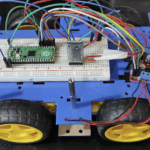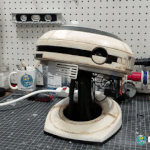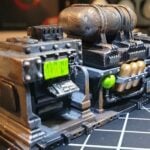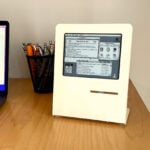Kimberlina Droid | The MagPi #116
Selin Ornek took inspiration from Star Wars when designing a Raspberry Pi Pico-powered battle bot.In the latest issue of The MagPi, out now, she talks strategy with Rosie Hattersley.

In Star Wars: Attack Of The Clones, a convoy of tanks with enormous wheels that bear down inexorably on their enemies was a fearsome sight. The concept seemed ideal to 15-year-old robot builder Selin Ornek when she needed ideas for a new battlebot. Having already made quite a name for herself in the world of coding, Selin was likely to have plenty of competitors keen to take her down, which partly explains why she named her battle bot Kimberlina in tribute to a comedy character from TV show Full House that she watched in lockdown. Kimberlina may have a quirky name, but her strike is deadly! Once you know something about Kimberlina’s maker, this won’t be a surprise.
Selin is an accomplished coder and Raspberry Pi robot builder. She began coding aged eight – first Scratch, but later Python, Java, and C++ – and designed her first robot at ten.

Her interest in coding began after Selina interviewed a family friend, who is a mechanical engineer, about building a robot dog as a means of bringing her much-loved dog, Korsan, back to life. His advice to learn coding and robotics, plus Scratch-based lessons that helped her class learn English, set Selin on her robot-building journey. She has now built six robots, including two that act as guide dog robots for blind people. The original version of this, the Arduino-based IC4U, won Selin her first prize at Coolest Projects International in 2018. “I won first place in the Hardware Category at Coolest Projects, and one of my prizes was a Raspberry Pi 3B+.” The other was a Google AIY kit – presented to her by Raspberry Pi’s very own Eben Upton. “After this, I started to use Raspberry Pi in all my projects.”

With a firm focus on using technology for good and demonstrating that an interest in computing is gender-free, Selin won the Aspiring Teen category in the 2021 Women In Tech Global Awards.
Firm foundations
Kimberlina began life as a cardboard prototype, which helped Selin decide on the parts she was going to use. The robot seemed a great opportunity to try out Raspberry Pi Pico for the first time, since she needed a microcontroller that could run motors, servos, and receive Bluetooth signals. Selin used the wheel design from her previous robot and designed other parts in Autodesk Tinkercad. “Because the wheel has a very small contact point with the ground, I had to find a way to balance the robot when it accelerates forward and backwards, so I placed steel ball bearings with enough space to move within the robot,” she says. The contest in which Kimberlina was to compete threw up challenges too, stipulating maximum weight and speed limitations. “The weight was a challenge after the decision to use ball bearings, but choosing the right motors was the key to [having] a fast-moving and turning robot.”

Decisions made, Selin 3D-printed and assembled Kimberlina’s body, using the time available while the body parts were printing to design a mobile app in MIT App Inventor to control the droid over Bluetooth. She used MicroPython to code Raspberry Pi Pico and the hardware connected to it. Once the coding was complete and the robot was assembled, it was time to test it. “I was lucky,” says Selin of how her meticulous planning and experience played out.

“Usually my robots do not work immediately. I come across a problem and sometimes even burn a part, but fortunately, Kimberlina worked on the first try.”
Speed and control

Kimberlina is controlled via Bluetooth from a mobile application Selin built using MIT App Inventor. A servo at the front controls the flipper to flip an opponent, while the servo at the back is attached to a lever that pushes the opponent away. “Kimberlina has great balance thanks to steel ball bearings that help centre it. This means that when it gets a hit or accelerates fast, it doesn’t roll over,” explains Selin. “My competition strategy was to move quickly and remain agile, avoiding contact, and make the other robots fall from the platform without touching them,” she adds. The mighty wheels of Hailfire, coupled with the portable power of Raspberry Pi Pico, proved an unbeatable combination.

Get The MagPi #116 NOW!
You can grab the brand-new issue right now from Tesco, Sainsbury’s, Asda, WHSmith, and other newsagents, including the Raspberry Pi Store in Cambridge. You can also get it via our app on Android or iOS. And there’s a free PDF you can download too.

You can also subscribe to the print version of The MagPi. Not only do we deliver it globally, but people who sign up to the twelve-month print subscription get a FREE Raspberry Pi Zero 2 W!





No comments
Comments are closed